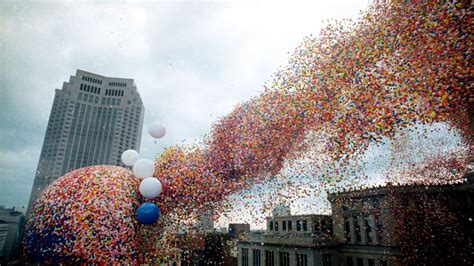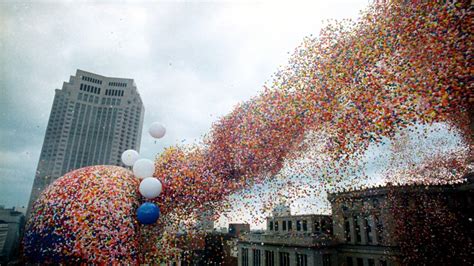
A 1986 Cleveland publicity stunt involving the release of 1.5 million balloons turned disastrous, causing widespread environmental problems, disrupting air traffic, and even contributing to a search and rescue effort that ended in tragedy, serving as a potent reminder of the unintended consequences of even well-intentioned events.
Cleveland’s Balloonfest ’86, initially conceived as a whimsical world record attempt and a visually stunning spectacle, quickly devolved into a multi-faceted crisis that continues to resonate decades later. The event, orchestrated by United Way of Cleveland to raise funds and generate positive publicity, released nearly 1.5 million helium-filled balloons over the city’s downtown area on September 27, 1986. While organizers envisioned a breathtaking display of color and civic pride, the sheer scale of the undertaking, combined with unfavorable weather conditions, resulted in a cascade of unforeseen and damaging repercussions.
The immediate aftermath of the balloon release saw thousands of balloons descending upon the city and its surrounding areas, blanketing Lake Erie and littering the landscape. This created immediate environmental hazards. The balloons, made of latex and other non-biodegradable materials, posed a significant threat to wildlife, with animals ingesting the debris and becoming entangled in the deflated balloons and strings. “The visual was impressive, but the impact was devastating,” noted a local environmentalist in the days following the event.
Beyond the environmental damage, Balloonfest ’86 had significant economic and operational impacts. Burke Lakefront Airport, located near downtown Cleveland, had to temporarily shut down due to the overwhelming number of balloons in the airspace, disrupting air traffic and causing delays for travelers. Motorists reported hazardous driving conditions as balloons obstructed visibility and created slippery surfaces on roadways. The city’s cleanup crews were overwhelmed by the sheer volume of debris, diverting resources from other essential services.
Tragically, the event may have indirectly contributed to a double drowning on Lake Erie. On the same day as Balloonfest ’86, two fishermen, Raymond Broderick and David Lamczyk, went missing. As reported by Cleveland Magazine, “The balloons interfered with the Coast Guard’s search efforts.” The massive influx of balloons on the lake’s surface made it difficult for rescue helicopters to spot the missing men, potentially delaying their recovery. While the connection between the balloon release and the fishermen’s fate remains a matter of speculation and legal debate, the timing and the obstruction caused by the balloons cast a long shadow over the event. Lamczyk’s body was later found ashore, while Broderick’s was never recovered. His wife subsequently sued United Way of Cleveland for $3.2 million, eventually settling out of court.
The Balloonfest ’86 debacle serves as a stark reminder of the importance of thoroughly assessing the potential risks and consequences of large-scale events. While the organizers undoubtedly had good intentions, their failure to adequately anticipate and mitigate the potential downsides of releasing such a massive number of balloons resulted in a public relations disaster, environmental damage, economic disruption, and potential loss of life. The event has since become a case study in event management, risk assessment, and environmental responsibility, highlighting the need for careful planning, contingency measures, and a deep understanding of the potential impacts of human actions on the environment and society.
In the years since Balloonfest ’86, awareness of the environmental hazards posed by balloon releases has grown significantly. Many jurisdictions have implemented regulations and bans on mass balloon releases, recognizing the potential harm to wildlife and the environment. Organizations such as the Balloon Council, an industry trade group, promote responsible balloon practices, advocating for the use of biodegradable balloons and discouraging intentional releases. The memory of Balloonfest ’86 continues to serve as a cautionary tale, reminding us that even seemingly harmless acts can have significant and far-reaching consequences. “It was supposed to be a celebration,” said one Cleveland resident reflecting on the event, “but it turned into a nightmare.”
The long-term effects of Balloonfest ’86 are still being felt today. Environmental groups continue to monitor the impact of plastic debris on Lake Erie and its surrounding ecosystems. Event organizers and city planners use the event as a case study to learn from past mistakes and improve their risk assessment practices. And for the residents of Cleveland, Balloonfest ’86 remains a vivid reminder of the day the sky filled with hope and good intentions, only to be followed by a storm of unintended consequences. The event’s legacy serves as a continuing lesson in the importance of environmental stewardship, responsible event planning, and the need to carefully consider the potential impacts of our actions, no matter how well-intentioned they may be. The event underscores the interconnectedness of human activities and the natural world, highlighting the responsibility we all share to protect the environment and prevent future disasters. The lessons learned from Balloonfest ’86 are applicable not only to event planning but also to a wide range of human endeavors, from technological innovation to social policy, reminding us to always consider the potential unintended consequences of our actions and to strive for solutions that are both effective and sustainable.
The legal ramifications of Balloonfest ’86 were also significant, with lawsuits filed against United Way and the event organizers. The lawsuits alleged negligence in planning and executing the event, claiming that the organizers failed to adequately assess the risks and take appropriate precautions. While some of the lawsuits were settled out of court, the legal battles further tarnished the event’s reputation and added to the financial burden on the organizations involved. The legal fallout from Balloonfest ’86 serves as a reminder of the importance of liability insurance and comprehensive risk management strategies for event organizers.
In addition to the environmental and economic impacts, Balloonfest ’86 also had a significant social impact on the city of Cleveland. The event sparked widespread criticism and condemnation, with many residents expressing anger and disappointment over the organizers’ lack of foresight and responsibility. The event also raised questions about the role of corporate sponsors in large-scale public events and the ethical considerations involved in using public resources for promotional purposes. The social fallout from Balloonfest ’86 serves as a reminder of the importance of transparency, accountability, and community engagement in event planning.
The legacy of Balloonfest ’86 extends beyond the city of Cleveland, serving as a cautionary tale for event organizers and policymakers around the world. The event has been cited in numerous academic studies, industry reports, and media articles as an example of the potential pitfalls of poorly planned and executed public events. The lessons learned from Balloonfest ’86 have helped to shape best practices in event management, risk assessment, and environmental sustainability. The event’s enduring legacy underscores the importance of learning from past mistakes and striving for continuous improvement in all aspects of event planning.
The planning of Balloonfest ’86 was ambitious, to say the least. United Way sought to break a world record and draw national attention to Cleveland and its charitable efforts. The event involved months of preparation, the recruitment of thousands of volunteers, and the coordination of numerous city agencies. The organizers secured permits from the city and the Federal Aviation Administration (FAA), but they failed to fully appreciate the potential risks associated with releasing such a massive number of balloons. The event’s planning process was also criticized for its lack of transparency and community engagement. Local residents and environmental groups were not adequately consulted about the potential impacts of the event, leading to a sense of resentment and mistrust. The planning process for Balloonfest ’86 serves as a reminder of the importance of inclusive and participatory decision-making in event planning.
The technological aspects of Balloonfest ’86 also played a role in the event’s ultimate failure. The balloons were filled with helium, a non-renewable resource that is used in a variety of scientific and medical applications. The release of such a large quantity of helium raised concerns about resource depletion and the environmental impact of helium extraction. The balloons were also equipped with strings, which posed a significant entanglement hazard to wildlife. The technological aspects of Balloonfest ’86 serve as a reminder of the importance of considering the environmental impact of the materials and technologies used in public events.
The media coverage of Balloonfest ’86 was initially positive, with news outlets focusing on the event’s record-breaking aspirations and its charitable purpose. However, as the negative consequences of the event became apparent, the media coverage shifted to a more critical tone. News reports highlighted the environmental damage, the economic disruption, and the potential connection to the drowning deaths of the two fishermen. The media coverage of Balloonfest ’86 serves as a reminder of the importance of responsible journalism and the need to hold event organizers accountable for their actions.
The aftermath of Balloonfest ’86 also saw a rise in public awareness about the environmental hazards posed by balloon releases. Environmental groups launched campaigns to educate the public about the dangers of balloons to wildlife and the environment. These campaigns led to increased public support for regulations and bans on mass balloon releases. The aftermath of Balloonfest ’86 serves as a reminder of the power of public awareness and advocacy in promoting environmental protection.
In conclusion, Cleveland’s Balloonfest ’86 was a well-intentioned event that went horribly wrong. The event’s legacy serves as a cautionary tale about the importance of careful planning, risk assessment, environmental stewardship, and community engagement in event planning. The lessons learned from Balloonfest ’86 are applicable to a wide range of human endeavors, reminding us to always consider the potential unintended consequences of our actions and to strive for solutions that are both effective and sustainable. The event underscores the interconnectedness of human activities and the natural world, highlighting the responsibility we all share to protect the environment and prevent future disasters. The memory of Balloonfest ’86 continues to serve as a reminder that even seemingly harmless acts can have significant and far-reaching consequences.
Frequently Asked Questions (FAQ)
Q1: What exactly was Balloonfest ’86 and what was its original purpose?
A1: Balloonfest ’86 was a promotional event organized by the United Way of Cleveland on September 27, 1986. The primary goal was to release a record-breaking number of balloons (nearly 1.5 million) to raise awareness and funds for the charity. It was intended to be a visually stunning spectacle that would generate positive publicity for the city and the United Way.
Q2: What were the main negative consequences of the Balloonfest ’86 event?
A2: The event had several negative consequences, including:
- Environmental Damage: Balloons littered Lake Erie and surrounding areas, posing a threat to wildlife through ingestion and entanglement.
- Air Traffic Disruption: Burke Lakefront Airport had to temporarily shut down due to the large number of balloons in the airspace.
- Possible Contribution to Tragedy: The balloons interfered with the search efforts for two missing fishermen on Lake Erie, potentially delaying their recovery and contributing to their deaths.
- Economic Costs: The cleanup efforts were extensive and costly, diverting resources from other city services.
- Legal Ramifications: Lawsuits were filed against United Way, leading to settlements and further tarnishing the event’s reputation.
Q3: How did the balloons interfere with the search for the missing fishermen?
A3: According to reports, the massive number of balloons floating on the surface of Lake Erie made it difficult for Coast Guard helicopters to spot the missing fishermen. The balloons obscured visibility and hampered the search efforts, potentially delaying the rescue operation. The wife of one of the missing fishermen sued United Way, alleging that the balloons contributed to her husband’s death.
Q4: What lessons were learned from Balloonfest ’86 in terms of event planning and environmental responsibility?
A4: Balloonfest ’86 highlighted the importance of:
- Thorough Risk Assessment: Event organizers need to carefully consider and mitigate potential risks and unintended consequences of large-scale events.
- Environmental Stewardship: Events should be planned with consideration for their environmental impact, and steps should be taken to minimize harm to wildlife and ecosystems.
- Community Engagement: Local residents and stakeholders should be consulted about the potential impacts of events, and their concerns should be addressed.
- Contingency Planning: Organizers should have contingency plans in place to deal with unforeseen circumstances, such as adverse weather conditions.
- Responsible Use of Resources: Events should be planned with consideration for the responsible use of natural resources, such as helium.
Q5: What regulations or changes have been implemented as a result of Balloonfest ’86?
A5: While there wasn’t a direct national regulation implemented solely as a result of Balloonfest ’86, the event contributed to growing awareness of the environmental hazards posed by balloon releases. This increased awareness has led to:
- Local and Regional Bans: Many cities and counties have implemented regulations or bans on mass balloon releases.
- Increased Public Awareness: Environmental groups have launched campaigns to educate the public about the dangers of balloons to wildlife and the environment.
- Industry Changes: The balloon industry has promoted the use of biodegradable balloons and discouraged intentional releases.
- Improved Event Planning Practices: Event organizers are now more likely to conduct thorough risk assessments and consider the environmental impact of their events.
- Legal Precedent: The lawsuits filed against United Way established a legal precedent for holding event organizers accountable for the negative consequences of their actions.








